
Gaurav Bhasin, Managing Director, Allied Advisers
According to Allied Advisors’s most recent report, any emerging SaaS firms are contemplating a Vertical SaaS model to target a specific niche, allowing them to focus better on client demands and making them easier to market.
Vertical SaaS is witnessing growing emergence of start-ups with smaller but more focused TAM (as compared with Horizontal SaaS) and more capital efficient business models.
COVID-19 severely impacted some Vertical SaaS niche markets but accelerated overall digital transformation across industries, followed by the realization that standardized solutions will not suffice.
We see continued investor interest in Vertical SaaS due to high growth prospects supported by strong business fundamentals, along with better performance on multiple metrics than peer Horizontal SaaS companies.
4 DRIVERS OF VERTICAL SAAS ARE:
1. Industry-specific solutions promotes growth
More robust and focused solutions that appeal to the client’s and the specific industry’s needs.
‒ Products and solutions are constantly updated in response to changing regulatory needs.
2. Higher upsell opportunities help growth
Immediate and significant value to companies looking for focused solutions; increased upsell opportunities due to the demonstrated value. ‒ As per studies, upsell costs only ~24% of the
cost of acquiring a new customer.
3. Lower S&M cost drives capital efficient growth
i. Focused and cost-effective approach to marketing due to narrowly defined customer requirements.
‒ Fewer marketing resources required and faster customer acquisition achieved.
ii. Blossom Street Ventures estimates that vertical companies can achieve up to 8x cheaper CAC vs
horizontal peers.
4. Increased customer trust drives demand
Having knowledge of the market and networking with key players acts as a distinct advantage and
builds customer confidence.
‒ Working closely with experts allows them to keep up with industry requirements and technical issues, leading to greater reliability, higher customization and better performance at industry-specific metrics and KPIs.
2 DRIVERS OF SAAS ARE:
1. Companies are typically focused on a smaller niche market, making it challenging to find new leads, and are exposed to adverse events impacting their target sector; e.g. COVID-19 had severely impacted VSaaS companies in sectors like hospitality and travel, helped companies in collaboration.
2. Lower TAM can be a key challenge with limited options to diversify; companies overcome this by providing additional offerings to existing customer base; e.g. Veeva expanded their product offerings to the healthcare sector rapidly increasing their growth and available TAM.
For a further insights on Allied Advisor’s full fall report, click below.
